Kingdom Fungi Higher classification Rhizoctonia | Division Basidiomycota Genus Rhizoctonia Rank Species | |
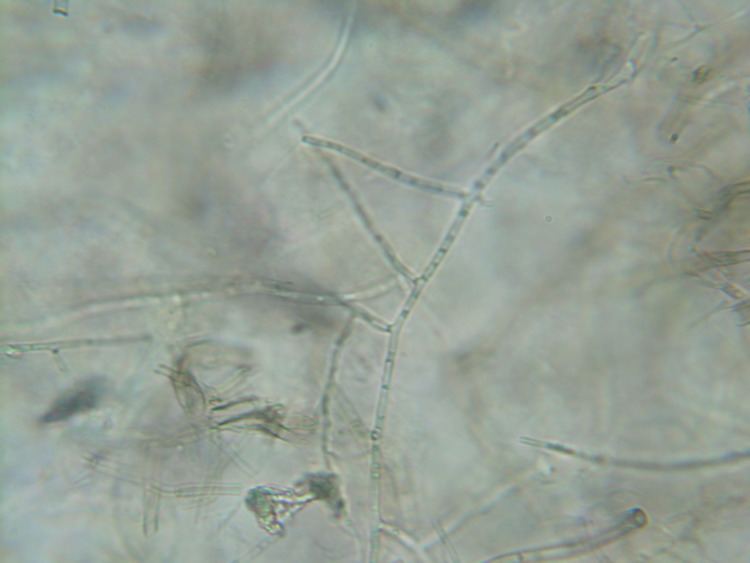 | ||
Similar Rhizoctonia, Pythium, Phytophthora, Fusarium oxysporum, Sclerotinia | ||
Rhizoctonia solani (teleomorph: Thanatephorus cucumeris) is a plant pathogenic fungus with a wide host range and worldwide distribution. It was discovered more than 100 years ago. R. solani frequently exists as thread-like growth on plants or in culture, and is considered a soil-borne pathogen. R. solani is best known to cause various plant diseases such as collar rot, root rot, damping off, and wire stem. R. solani attacks its hosts when they are in their early stages of development, such as seeds and seedlings, which are typically found in the soil. The pathogen is known to cause serious plant losses by attacking primarily the roots and lower stems of plants. Although it has a wide range of hosts, its main targets are herbaceous plants. R. solani would be considered a basidiomycete fungus if the teleomorph stage were more abundant. The pathogen is not currently known to produce any asexual spores (conidia), though it is considered to have an asexual lifecycle. Occasionally, sexual spores (basidiospores) are produced on infected plants. The disease cycle of R. solani is important in management and control of the pathogen.
Contents
- Rhizoctonia solani video prepared by Boyapati Ravi Teja Naidu and Rajat Kumar
- History
- Hosts and symptoms
- Disease cycle
- Environment
- Identification
- Management
- Economic importance
- Genome
- References
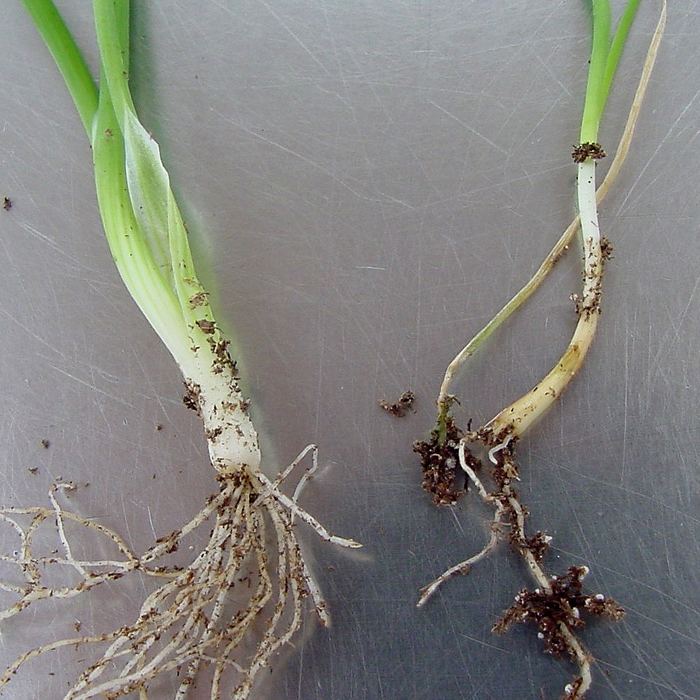
Rhizoctonia solani video prepared by Boyapati Ravi Teja Naidu and Rajat Kumar
History
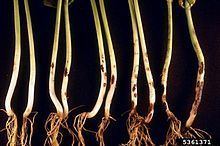
In 1858, Julius Kuhn observed and described a fungus on diseased potato tubers and named it Rhizoctonia solani. Rhizooctonia is from Ancient Greek, ῥίζα (rhiza, "root") + κτόνος (ktonos, "murder"). Solanum, Latin for nightshade, is the genus of the potato. The disease caused was well-known before the discovery and description of the fungus.
Hosts and symptoms
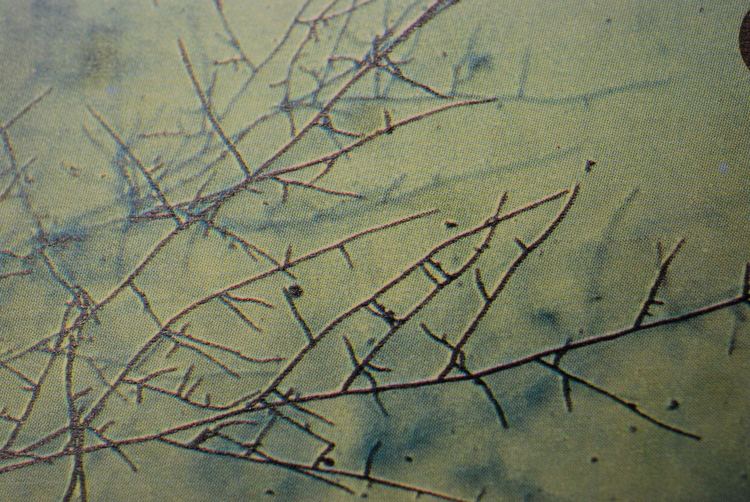
R. solani causes a wide range of commercially significant plant diseases. It is one of the fungi responsible for brown patch (a turfgrass disease), damping off (e.g. in soybean seedlings), black scurf of potatoes, bare patch of cereals, root rot of sugar beet, belly rot of cucumber, sheath blight of rice, and many other pathogenic conditions. The fungus, therefore, has a wide host range and strains of R. solani may differ in the hosts they are able to infect, the virulence of infection, selectivity for a given host ranges from nonpathogenic to highly virulent, the temperature at which infection occurs, the ability to develop in lower soil levels, the ability to form sclerotia, the growth rate, and survival in a certain area. These factors may not always show up given the environment and host that Rhizoctonia attacks.

R. solani primarily attacks seeds of plants below the soil surface, but can also infect pods, roots, leaves, and stems. The most common symptom of Rhizoctonia is "damping off", or the failure of infected seeds to germinate. R. solani may invade the seed before it has germinated to cause this pre-emergent damping off, or it can kill very young seedlings soon after they emerge from the soil. Seeds that do germinate before being killed by the fungus have reddish-brown lesions and cankers on stems and roots.
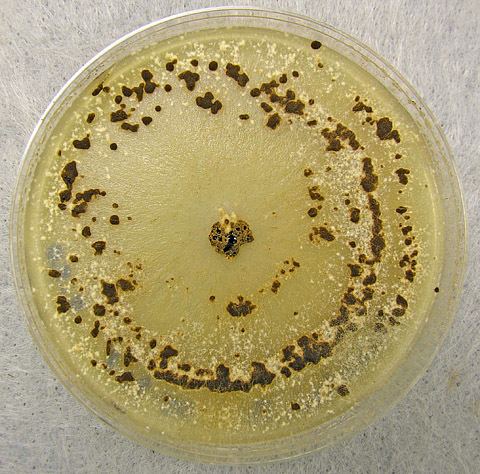
Various environmental conditions put the plant at higher risk of infection due to Rhizoctonia, the pathogen prefers warmer, wet climates for infection and growth. Postemergent damping off is a further delay in attack of R. solani. The seedling is most susceptible to disease in its early stages.
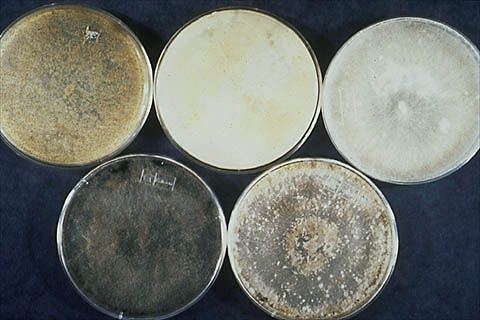
Cereals in regions of England, South Australia, Canada, and India experience losses caused by R, solani every year. Roots are killed back, causing plants to be stunted and spindly. Other noncereal plants in those regions can experience brown stumps as another symptom of the pathogen. In England, this is called purple patch. R. solani can also cause hypocotyl and stem cankers on mature plants of tomatoes, potatoes, and cabbages. Strands of mycelium and sometimes sclerotia appear on their surfaces. Roots turn brown and die after a period of time. The best known symptom of R. solani is black scurf on potato tubers, which are the sclerotia of the fungus.
Disease cycle
R. solani can survive in the soil for many years in the form of sclerotia. Sclerotia of Rhizoctonia have thick outer layers to allow for survival, and they function as the overwintering structure for the pathogen. In some rare cases (such as the teleomorph) the pathogen may also take on the form of mycelia that reside in the soil, as well. The fungus is attracted to the plant by chemical stimuli released by a growing plant and/or decomposing plant residue. The process of penetration of a host can be accomplished in a number of ways. Entry can occur through direct penetration of the plant cuticle/epidermis or by means of natural openings in the plant. Hyphae come in contact with the plant and attach to the plant by which through growth they begin to produce an appressorium which penetrates the plant cell and allows for the pathogen to obtain nutrients from the plant cell. The pathogen can also release enzymes that break down plant cell walls, and continues to colonize and grow inside dead tissue. This breakdown of the cell walls and colonization of the pathogen within the host forms the sclerotia. New inoculum is produced on or within the host tissue, and a new cycle is repeated when new plants become available. The disease cycle begins as such:
- Sclerotia/mycelium overwinter in plant debris, soil, or host plants.
- The young hyphae and fruiting basidia (rare) emerge and produce mycelia and rarely basidiospores.
- The very rare production of the germinating basidiospores penetrate the stoma, whereas the mycelia land on the plant surface and secrete the necessary enzymes onto the plant surface to initiate invasion of the host plant.
- After the mycelia successfully invade the host, necrosis and sclerotia form in and around the infected tissue which then leads to the various symptoms associated with the disease, such as soil rot, stem rot, damping off, etc. and the process begins all over again.
Environment
The pathogen is known to prefer warm, wet weather, and outbreaks typically occur in the early summer months. Most symptoms of the pathogen do not occur until late summer, thus most farmers do not become aware of the diseased crop until harvest. A combination of environmental factors has been linked to the prevalence of the pathogen, such as presence of host plant, frequent rainfall/irrigation, and increased temperatures in spring and summer. In addition, a reduction of drainage of the soil due to various techniques such as soil compaction are also known to create favorable environments for the pathogen. The pathogen is dispersed as sclerotia, and these sclerotia can travel by means of wind, water, or soil movement between host plants.
Identification
R. solani does not produce spores, hence is identified only from mycelial characteristics or DNA analysis. Its hyphal cells are multinucleated. It produces white to deep brown mycelium when grown on an artificial medium. The hyphae are 4–15 μm wide and tend to branch at right angles. A septum near each hyphal branch and a slight constriction at the branch are diagnostic. R. solani is subdivided into anastomosis groups based on hyphal fusion between compatible strains.
The teleomorph of R. solani is Thanatephorus cucumeris. It forms club-shaped basidia with four apical sterigmata on which oval, hyaline basidiospores are borne.
Management
Complete control of Rhizoctonia species is not possible, but the severity of the pathogen can be limited. Successful control depends on characteristics of the pathogen, host crops, and the environment. Controlling the environment, crop rotation, using resistant varieties, and minimizing soil compaction are effective and noninvasive ways to manage disease. Planting seedlings in warmer soil and getting plants to emerge quickly helps minimize damage. Crop rotation also helps minimize the amount of inoculum that results in infection. A few resistant varieties with moderate resistance to Rhizoctonia can be used, but they produce lower yields and quantity than standard varieties. Minimizing soil compaction helps water infiltration, drainage, and aeration for the plants.
One specific chemical option is a chemical spray PCNB, which is known to be the best solution to reducing damping off of seeds on host plants. To minimize disease, certified seed free of sclerotia can be planted. Seed growers should only purchase sclerotia-free seeds when planting their crops since sclerotia can overwinter in the soil and may not show symptoms right away. Although fungicides are not the most effective way to manage this pathogen, a few that have been approved by the USDA for control of the pathogen. Chemical company representatives can recommend which group of fungicides would be most effective with crops in regard to R. solani.
As long as seed growers stay clear of wet, poorly drained areas while also avoiding susceptible crops, R. solani is not usually a problem. Diseases caused by this pathogen are more severe in soils that are moderately wet and a temperature range of 15–18°C.
Economic importance
Rhizoctonia can be found across all areas of the United States (environmental conditions permitting) where its host crops are located. The severity of infection can vary and for highly infected patches, severity of the infection can be very devastating to the farmer. Some of these consequences are major yield losses (from 25% to 100%), increased soil tare (because the soil sticks to the fungus' mycelium), and poor industrial quality of the crops based on increased levels of sodium, potassium, and nitrogen. Due to the number of hosts that the pathogen attacks, these consequences are numerous and detrimental to a variety of crops. Sheath blight caused by this pathogen is the second-most devastating disease after rice blast.
Genome
The draft genome of R. solani strain Rhs1AP covers 51.7 Mbp, although the heterokaryotic genome of this strain was estimated at 86 Mb, based on an optical map of the chromosomes. The discrepancy is explained by the aneuploid, highly repetitive genome of this species which prevented sequencing (or assembling) the complete DNA. The genome is predicted to encode 12,726 genes. Another strain, AG1-IB 7/3/14, was recently sequenced too.
